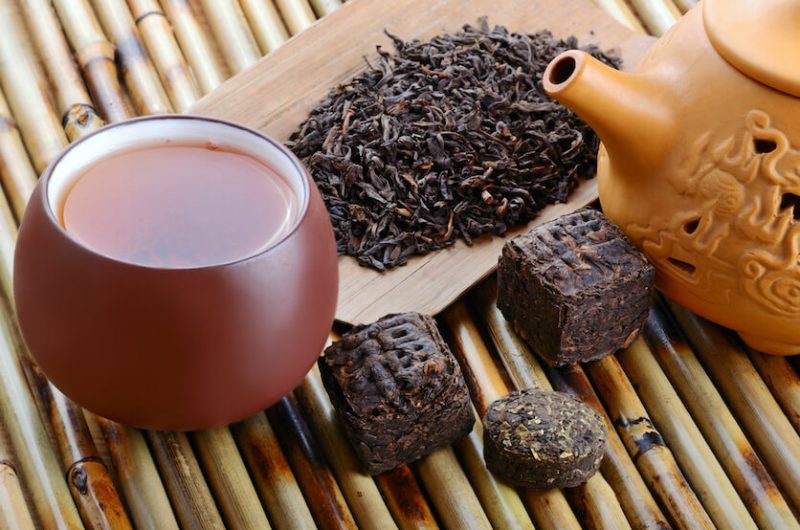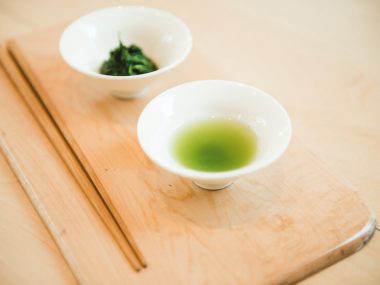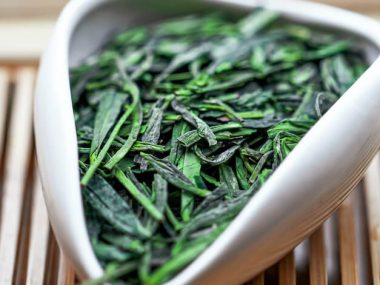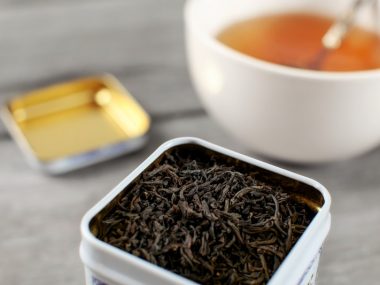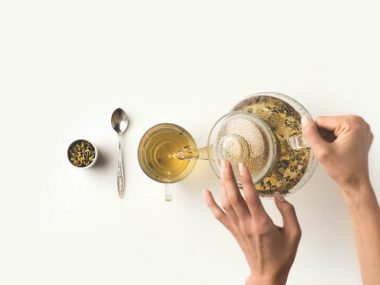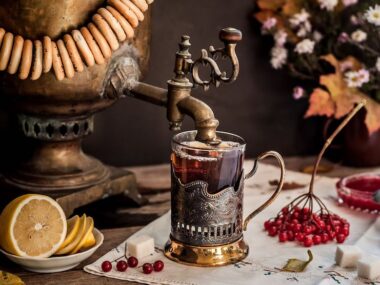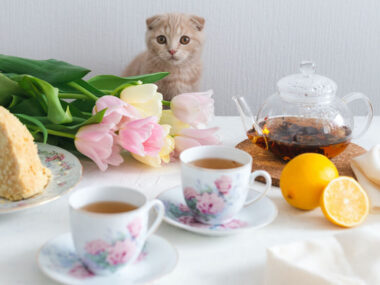If there were a tea that radiated with beauty and the ability to slow time, this is the one. Pu-erh is more than a tea. It’s a powerful time warp that pulls you into a place void of ticks and tocks, where utter rest and peace prevail.
Table of Contents
What Is Pu-erh Tea?
Pu-erh tea is a post-fermented tea made from the leaves of Camellia sinensis. This tea is only produced in the Yunnan Province of China. What sets pu-erh tea apart from the other true teas is its processing method, taste, price, and shelf life.
This tea is named after its birthplace, “Pu’er City,” in the Yunnan Province of China. There are ancient tea trees scattered throughout the region that date back up to 1,000 years.
Jinghong Zhang (anthropologist, pu-erh expert, and author of “Puer Tea: Ancient Caravans and Urban Chic“) eloquently stated in her book several key points about pu-erh that explain its stronghold of significance. Her book features how culture has built itself around pu-erh.
- “Pu-erh has a very distinctive feature which is its link to time.”
- “Pu-erh is symbolic of Yunnan culture’s “conscious construction.”
There’s much to be said about the connection one experiences to the historical process and uniqueness of such a symbolic tea. As you savor each sip of this tea, you become a part of the culture that embraces the fragility of time.
Forms Of Pu-erh Tea
Pu-erh tea is best recognized for its unique disc-like (cake) form. This cake of tea may never find its way into a teacup for years, as much as 50 years or more! However, pu-erh can also be processed into loose-leaf tea. The journey of pu-erh from the tea leaf to a teacup is intriguing!
Compressed
This form of pu-erh is the most common method. You’ll hear several terms referencing compressed tea, such as “cake” or “brick.” Different shapes of molds produce a round, concave disc (similar to a frisbee or dinner plate) or a more melon-like form (similar to a pumpkin.) It’s not unusual to find small pu-erh cakes on occasion. Cakes of this tea go on to be stored and aged where post-fermentation occurs.
Loose-Leaf
Loose-leaf pu-erh is less common than its cake counterpart, but it provides consumers a more affordable option to enjoy a post-fermented tea. This form of pu-erh is absent of the aged, post-fermentation.
Types Of Pu-erh Tea
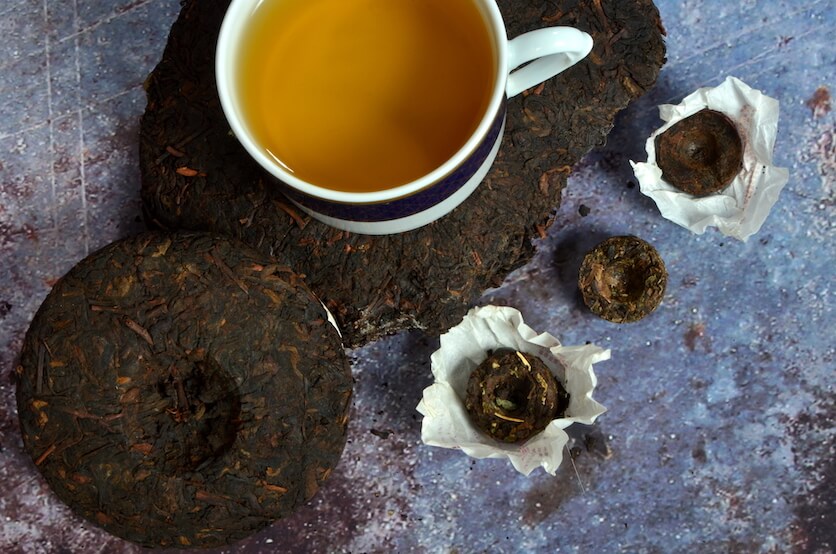
There are several types of this tea variety. Pu-erh is considered either raw, ripe, or aged. Each of these is respective to where it falls within fermentation.
Raw
This pu-erh consists of tea leaves that have gone through harvesting, wilting, kneading, and drying. It can either be in loose-leaf or cake form which goes on to be marketed in the tea industry.
Consumers have the option to enjoy this tea immediately or to put it away to age and enjoy it later. To give you an idea of how long it takes raw pu-erh to fully age, one would have to put this tea away for up to 30 years to achieve an aged tea.
Ripe
Ripe pu-erh is a raw pu-erh that undergoes a forced/artificial fermentation. However, forced fermentation is achieved through the manipulation of storage conditions to speed up the process. It usually takes up to 3 months to ripen pu-erh.
Something to keep in mind when enjoying this type of pu-erh is although it may be attainable and affordable, its natural aging process is altered for the sake of convenience and price.
“Artificial interference with food transforms it from natural to cultural.” – Claude Levi-Strauss
Aged
Aged pu-erh tea cakes are placed into storage where it’s allowed to naturally age. For pu-erh to be considered “aged,” it must have been stored and allowed to naturally age for a minimum of 5 years. Aged tea cakes can be hundreds of years old. Storage is crucial to achieving the best quality in an aged cake.
The History Behind Pu-erh Tea
Back in ancient times (more than 1,700 years ago), pu-erh tea heavily traveled the Silk Road that spanned numerous countries from China to Italy. Pu-erh (which was highly valuable) was elemental back then to measure commodity value when bartering for things. One who was lucky enough to own a pu-erh cake was considered wealthy.
No one dared to break open their pu-erh cake, but instead, they protected it and kept it as an heirloom which was passed down to numerous generations. It was also part of an unwed woman’s dowry upon marrying. The older the pu-erh cake grew, the more valuable it became.
The oldest pu-erh cake on record today is the Golden Melon Tribute Cake. It is over 100 years old and was a gift to Emperor Guangxu of the Qing Dynasty. It was discovered sitting in a storage warehouse in Beijing back in the 1960s. It was then put on display at the Palace Museum in Beijing and has since traveled back to Pu’er City in Yunnan. During that travel time, the cake was insured for 20 million yuan (equivalent to $2.6 million).
Why Is Pu-erh So Expensive?
A genuine, natural aging pu-erh is costly due to the way the tea is processed and stored. The mounting costs of keeping the tea warehoused and under a watchful eye do not come at a cheap price. One who buys a cake of this tea is making an investment or buying an extremely valuable luxury to enjoy.
Investors purchase pu-erh cakes to store just as if it were a fine wine. To give you an idea of just how valuable pu-erh tea is, a 100-year-old cake (Blue Ticket Song Pinhao) sold for $13.32 million (HK.) Another century-old cake (Fu Yuan Chang) sold for $26.32 million (HK) ($3.3 million USD.)
What Does Pu-erh Tea Taste Like?
There are many opinions on what this tea tastes like. However, it’s said that a properly aged, genuine pu-erh will taste sweet with a hint of fruit. It should never taste earthy. Raw pu-erh has similar flavor profiles as green tea. Ripe pu-erh is more earthy and sweet. Naturally, aged pu-erh is superb in mellowness with lovely hints of sweet floral.
How Much Caffeine Is In Pu-erh Tea?
Pu-erh tea caffeine is similar to that of any black or green tea. You can expect to have up to 70 mg of caffeine in a 6-ounce cup of pu-erh tea. A raw or ripe pu-erh contains more caffeine compared to its naturally aged counterpart.
Can I Drink Pu-erh Tea Everyday?
Just as with any other type of tea, it’s best to consult with your healthcare provider before consuming tea. Constituents in tea may cause side effects, adverse reactions, interact with certain medications, or cause a medical condition to worsen.
Is Pu-erh Better Than Green Tea?
Both of these teas are equally beneficial and flavorful. However, there are some discerning tea palates that prefer one over the other. Raw pu-erh is very similar to green tea in color, body, and flavor. Most green teas are inherently earthy. Those who are black tea drinkers find raw (and perhaps ripe) pu-erh tea undesirable. However, naturally aged pu-erh is very enjoyable.
Caffeine is lower in naturally aged pu-erh, whereas raw and ripe pu-erh have similar levels of caffeine as green tea. When it comes to health benefits, pu-erh and green tea have very few differences. Both of these teas have a lot to offer. Basically, it comes down to a personal flavor preference and what one is willing to pay for their tea.
What Are The Benefits Of Drinking Pu-erh Tea?
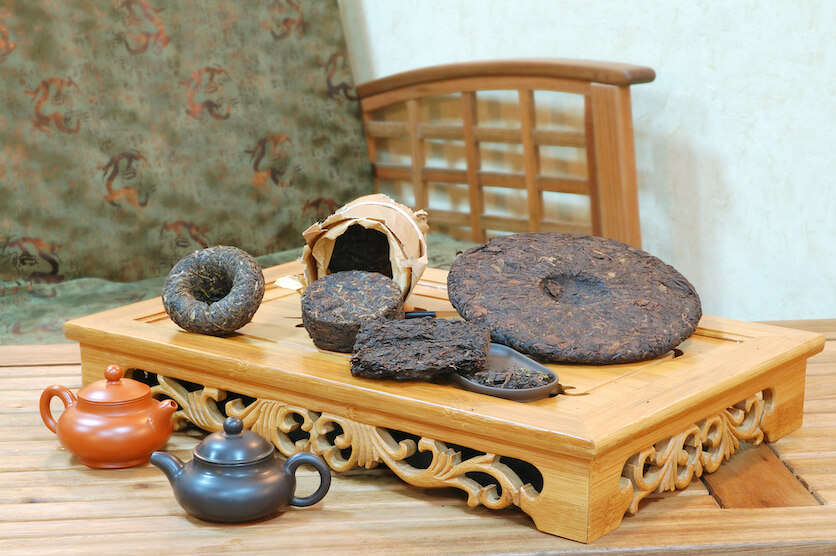
A research study (Reduction of body fat and improved lipid profile associated with daily consumption of a Puer tea extract in a hyperlipidemic population: a randomized placebo-controlled trial) notes that pu-erh contributes to significant weight loss, a decrease in cholesterol, and reduction in appetite.
One of pu-erh tea’s benefits is having a supply of tea that never goes bad. Pu-erh tea has an indefinite shelf life when properly stored. An aged pu-erh evokes a state of relaxation and well-being, and perhaps that is attributed to having access to that luxury due to the value of the tea as it ages.
How To Brew Pu-erh Tea
Brewing such a valuable tea tends to make some a bit nervous in fear of ruining the tea. It’s not that difficult.
Ingredients
- 2 cups of water
- 1 teaspoon of pu-erh tea
Directions
- Heat the water until it reaches 185 degrees (F.)
Tip: Do not boil the water; otherwise, it can cause the tea to be very bitter.
- Remove from the heat.
- Place the tea into a tea infuser and drop it into the hot water.
- Cover and allow it to steep for 4 minutes.
- Remove the cover and tea infuser.
- Pour the tea into a cup and enjoy.
A Cultural Experience
Pu-erh tea is not like other teas. The cultural cloak of beauty that embraces this tea and its uniqueness makes it invaluable. It’s a tea that touches the soul.
